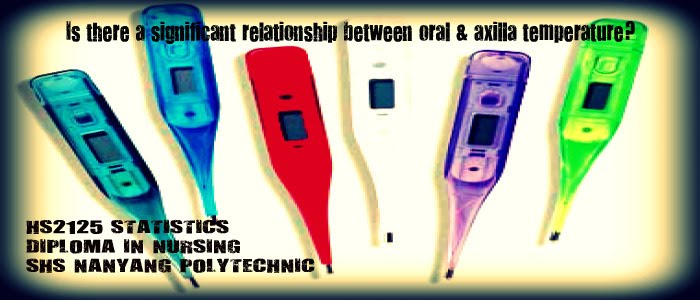Monday, July 19, 2010
WELCOME!
Our group members are:
Xinning
Samantha
Jie Lun
Rudiani
The last post indicates how we first started the proj, so scroll from the bottom to up.
Thank you & enjoy! (=
How we went about it
There are various ways to measure body temperature, via :
Oral: in the mouth, under the tongue
Axilla: under the armpit
Rectal: in the anus
Tympanic: from the ear drum in the ear canal
Skin: on the forehead
Our research question:
Is a person's oral temperature related to his/her axilla temperature?
Defining the variables:
Variable 1: Oral temperature
Variable 2: Axillary temperature
Extraneous variables: Gender
Conceptualization:
Oral temperature: temperature taken under the tongue of the subject
Axilla temperature: temperature taken under the axilla/armpit of the subject
Literature review:
Body Temperature: Normal range, Fever, and Thermometer Types
Normal oral, rectal, tympanic and axillary body temperature in adult men and women: a systematic literature review
Temperature of a Healthy Human (Body temperature)
Comparison of Axillary Temperature with Rectal or Oral Temperature
and Determination of Optimum Placement Time in Children
A comparison between infrared tympanic thermometry, oral and axilla with rectal thermometry in neutropenic adults
Rectal, ear, oral, and axillary temperature comparison
Is axillary temperature an appropriate surrogate for core temperature?
How reliable is axillary temperature measurement?
Operationalization:
1.We gathered our samples by measuring the oral temperature & axilla temperature of our schoolmates using an electronic digital thermometer.
2. Calibration- The temperatures are measured using the same brand of electronic thermometers. They have been pre-checked to ensure they register readings that are within (plus minus)0.1 degree when measuring from the same cup of warm water at the same time.
3. Thermosheaths were also used for both oral and axilla temperature taking to maintain consistency.
4. We took measurements of both temperature routes for each individual TWICE to obtain an AVERAGE.
5. The data was collected from a group of healthy males and females from 17 to 24 yrs old.
What can affect the test:
Inaccurate temperature readings can be caused by:
- Not keeping your mouth closed around the thermometer when taking an oral temperature.
- Not leaving a thermometer in place long enough before reading it.
- Not putting the proper thermometer in the right place.
- Not following the instructions for proper use that come with the thermometer.
- A weak or dead thermometer battery.
- Taking an oral temperature within 20 mins after smoking or drinking a hot or cold liquid.
- Taking a temperature by any method within an hour of exercising vigorously or taking a hot bath.
Precautions taken during operationalization:
- Fresh batteries were inserted in all test electronic thermometers.
- We reminded all subjects to place the thermometer under their tongues and keep their mouth closed around the thermometer.
- We only remove the thermometer from under the tongue or armpit when it beeped to indicate that it was in place long enough to register a stable temperature.
- The temperatures were taken at the end of the first morning lectures at NYP so that:
- There is at least an hour's gap from any consumed hot drink or food (to minimize the influence of hot food on body temperature), and
- The subjects would be at rest (to minimize the impact of any physical exertion on body temperature).
Thursday, June 17, 2010
Approach and rationale to our statistical analysis
Overall, the data collected was good and there was no rejection.
Hypothesis Testing
1. Null Hypothesis: There is NO significant relationship between a person's oral temperature and axilla temperature.
2. Alternative Hypothesis: There IS a significant relationship between a person's oral temperature and axilla temperature.
Criteria to "Reject" or "Accept" the Null Hypothesis:
1. The decision rests on the p-value test statistic in relation to the user-defined α (alpha).
2. Alpha refers to the significance level. At this critical region, the range of values of the test statistic indicates that there IS a significant relationship and that the null hypothesis is rejected.
3. If the test statistic falls in the critical region (ie. p-value is ≤ α), it would lead to the rejection of the Null Hypothesis. In other words:
If p is ≤ α, we REJECT the Null Hypothesis.
If p is > α, we FAIL TO REJECT null hypothesis and we've to ACCEPT the Alternative Hypothesis.
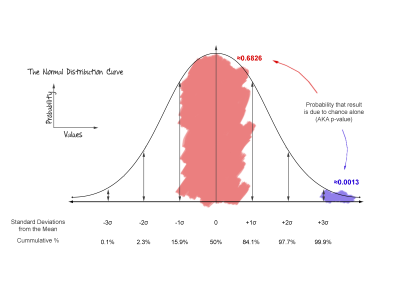
In our study, we have set α at 0.05.

Choosing an appropriate statistical test
The statistical test depends whether the research question is about:
- Difference, or
- Correlation.
Our study is about correlation.

source: Chia, C. Y. (2008). Statistics in health sciences. (4th ed.). Singapore: McGraw Hill Education
Since both of our variables in question are scale variables, and guided by the above decision path, we use Pearson's r to do the testing.
What is Pearson's r?
1. Pearson's r let us know the strength and direction of the linear association between two scale variables.
2. This correlation coefficient indicates the strength of the correlation.
3. Its limit ranges from -1 to +1. The + or - values indicates the direction of the correlation and lets us know how the variables are related.
4. Values near -1 indicates a strong negative relationship and is visually represented by a downward slope of the samples in a graph, while values near +1 indicates a strong positive relationship and an upward slope of the graph.
5. The closer the correlation coefficient approaches zero, the weaker the relationship between the two variables.
Tuesday, June 8, 2010
SPSS and interpreting the results

Variable view.

Data view
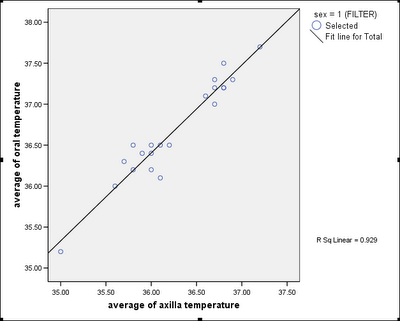 Using the data, we generated a Scatter Plot of Oral vs Axilla Temperature for Female.
Using the data, we generated a Scatter Plot of Oral vs Axilla Temperature for Female.
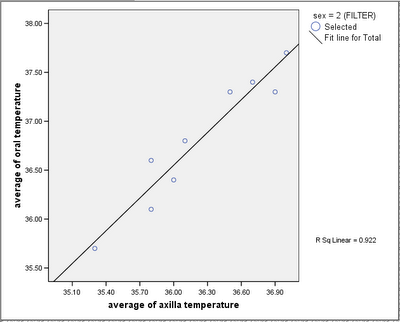 And also a Scatter Plot of Oral vs Axilla Temperature for Male.
And also a Scatter Plot of Oral vs Axilla Temperature for Male.
This is the Pearson's R coefficients for Females & Males in the following table: 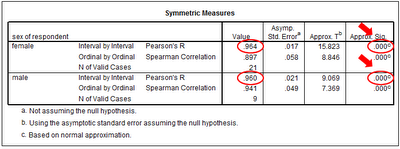
The table shows Pearson's correlation coefficients of 0.964 for Females & 0.960 for Male.
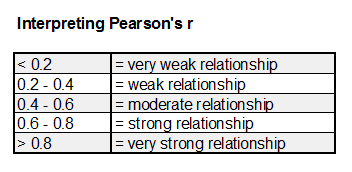
The association for Males is r=0.960, p=0.000, N=9 and the [Female]'s association is r=0.964, p=0.000, N=21.
Both are >0.8, indicating a VERY STRONG, SIGNIFICANT and POSITIVE relationship between a person's oral & axilla temperatures for both Males and Females.
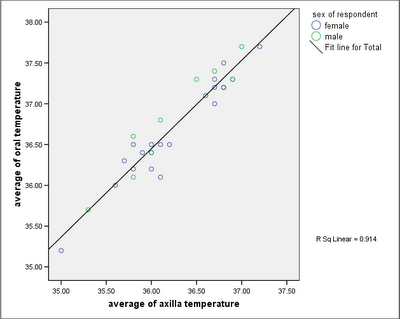 A Scatter Plot of oral temperature vs axilla temperature for BOTH Male & Female.
A Scatter Plot of oral temperature vs axilla temperature for BOTH Male & Female.
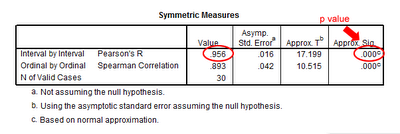
The COMBINED table above shows the Pearson's correlation coefficient of 0.956 for Males & Females (ie. ALL samples). It indicates a VERY STRONG, SIGNIFICANT and POSITIVE RELATIONSHIP between oral temperature and axilla temperature for Males & Females.
---------------------------------------------------------------------------
COMPUTING THE REGRESSION LINES FOR Males, Females and Males & Females (ie. y = mx + c)
Since a relationship exists between oral and axilla temperatures, we now perform linear regressions using SPSS to construct equations that can predict a person's oral temperature from his/her axilla temperature.
The data table below is for Females samples.
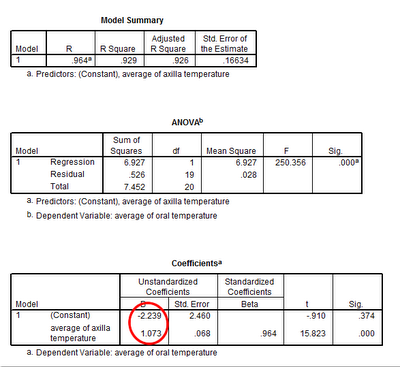
The linear equation for Female is
Oral Temp Female = 1.073 x (Axilla Temp Female) - 2.239 °C
The data table below is for Male samples.
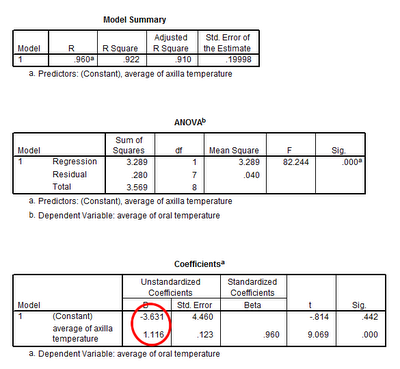
The linear equation for Males is
Oral Temp Males = 1.116 x (Axilla Temp Male) - 3.631 °C
The data table below is for Male & Female samples.
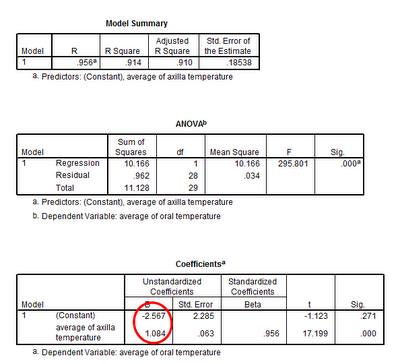
The linear equation for Male & Female is
Oral Temp = 1.084 x (Axilla Temp) - 2.567 °C
---------------------------------------------------------------------------
HYPOTHESIS TESTING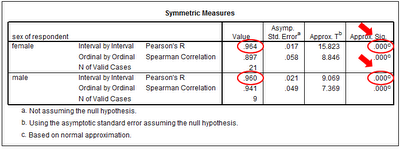
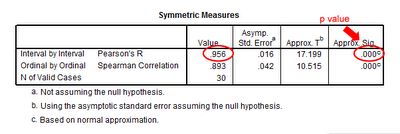
We had earlier selected the critical value or common significance level or α at 0.05.
Since the p values (red arrows) for Males, Females and Males & Females are ALL = 0.000 which is less that our alpha of 0.05, WE REJECT OUR NULL HYPOTHESIS.
Thus, we ACCEPT our ALTERNATIVE HYPOTHESIS that THERE IS A SIGNIFICANT RELATIONSHIP BETWEEN A PERSON'S ORAL AND AXILLA TEMPERATURE (specifically a positive one).
Saturday, June 5, 2010
In general, for the same individual:
Axilla (armpit) temperature is usually 0.3 to 0.6 lower than an oral temperature.
Oral temperature is about 0.3 to 0.6 lower than a rectal or ear (tympanic) temperature.
Conversely, Tympanic (ear) and Rectal temperatures are 0.3 to 0.6 higher than oral temperature.
The following table shows the normal ranges for human temperature taken using different routes as reported by Sund-Levander M, Forsberg C, Wahren LK.:

While debate remains as to whether 'core body temperature' taken using the rectal route best reflect the body's 'true' internal temperature, factors like:
embarrassment to the patient,
inconvenience to the patient and nurse,
ease of use for the nurse,
expediency and
speed and accuracy in obtaining temperature readings, etc
All mean that tympanic thermometers are favoured in adult wards as the temperature can be obtained in ONE second instead of waiting for a minute or even longer for an electronic oral thermometer.
However, axilla temperature is taken using electronic themometers for children under 6 months in pediatrics wards since their ear canals are still not large enough to accomodate a regular tympanic thermometer.
